Analysis of Reliability, FMEA, and Monitoring Systems for Vehicles
VerifiedAdded on 2023/01/12
|7
|2123
|49
Report
AI Summary
This report provides an overview of the motor vehicle industry's development, highlighting key milestones and the evolution of reliability methodologies. It details various condition monitoring techniques employed to assess machinery health and predict potential failures, including proactive, predictive, and reactive maintenance. The report then delves into Failure Mode and Effects Analysis (FMEA) and Reliability Block Diagrams (RBD), comparing their advantages and disadvantages, particularly focusing on the quantitative RBD method versus qualitative FMEA. Furthermore, the report proposes a comprehensive monitoring system designed to prevent errors and enhance efficiency, encompassing both operational condition monitoring and subsystem failure prevention. The proposed system incorporates data collection, framework definition, cost analysis, communication processes, and organizational structure to ensure effective implementation and operation. The conclusion summarizes the key findings, emphasizing the importance of reliability and monitoring in the motor vehicle industry.
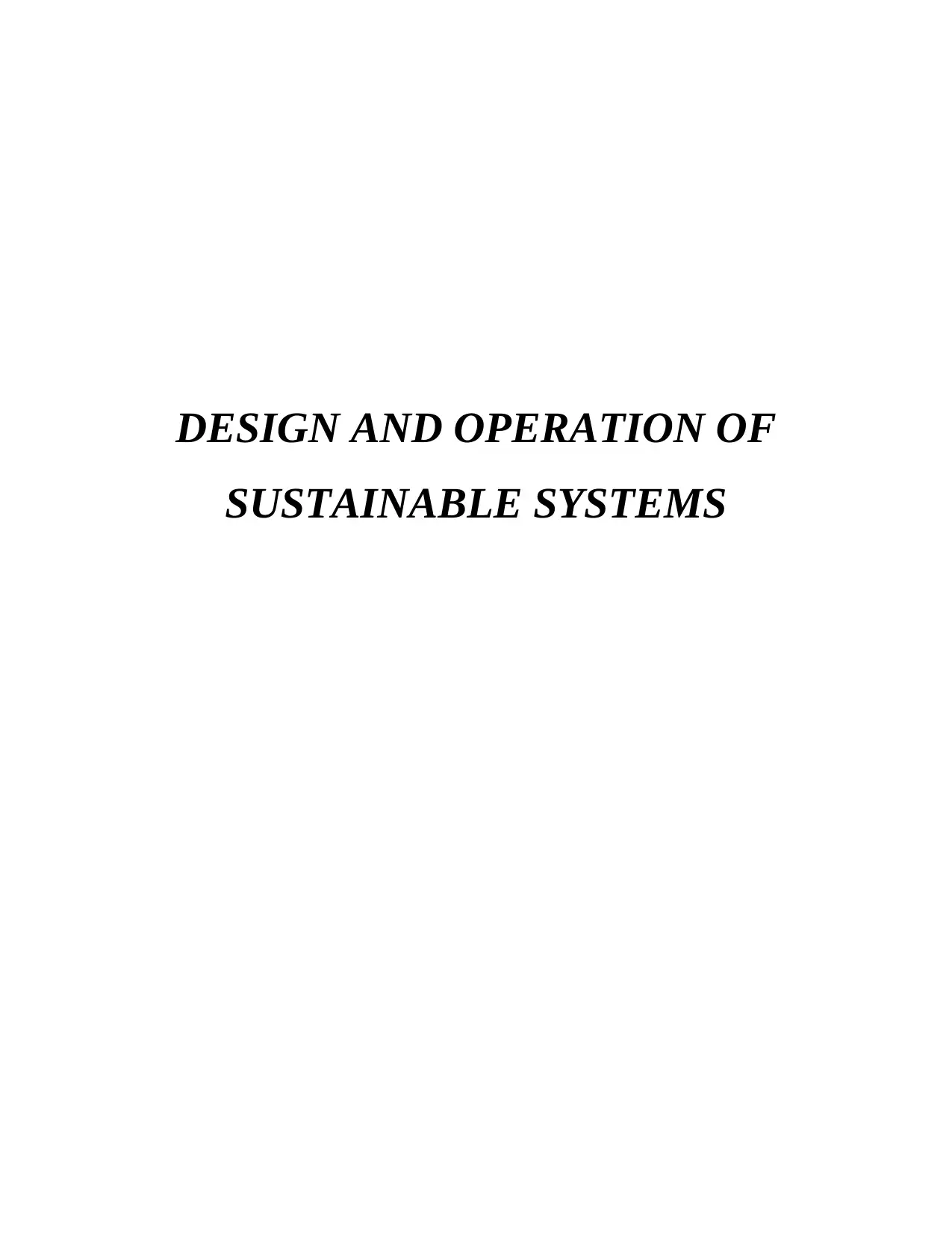
DESIGN AND OPERATION OF
SUSTAINABLE SYSTEMS
SUSTAINABLE SYSTEMS
Paraphrase This Document
Need a fresh take? Get an instant paraphrase of this document with our AI Paraphraser
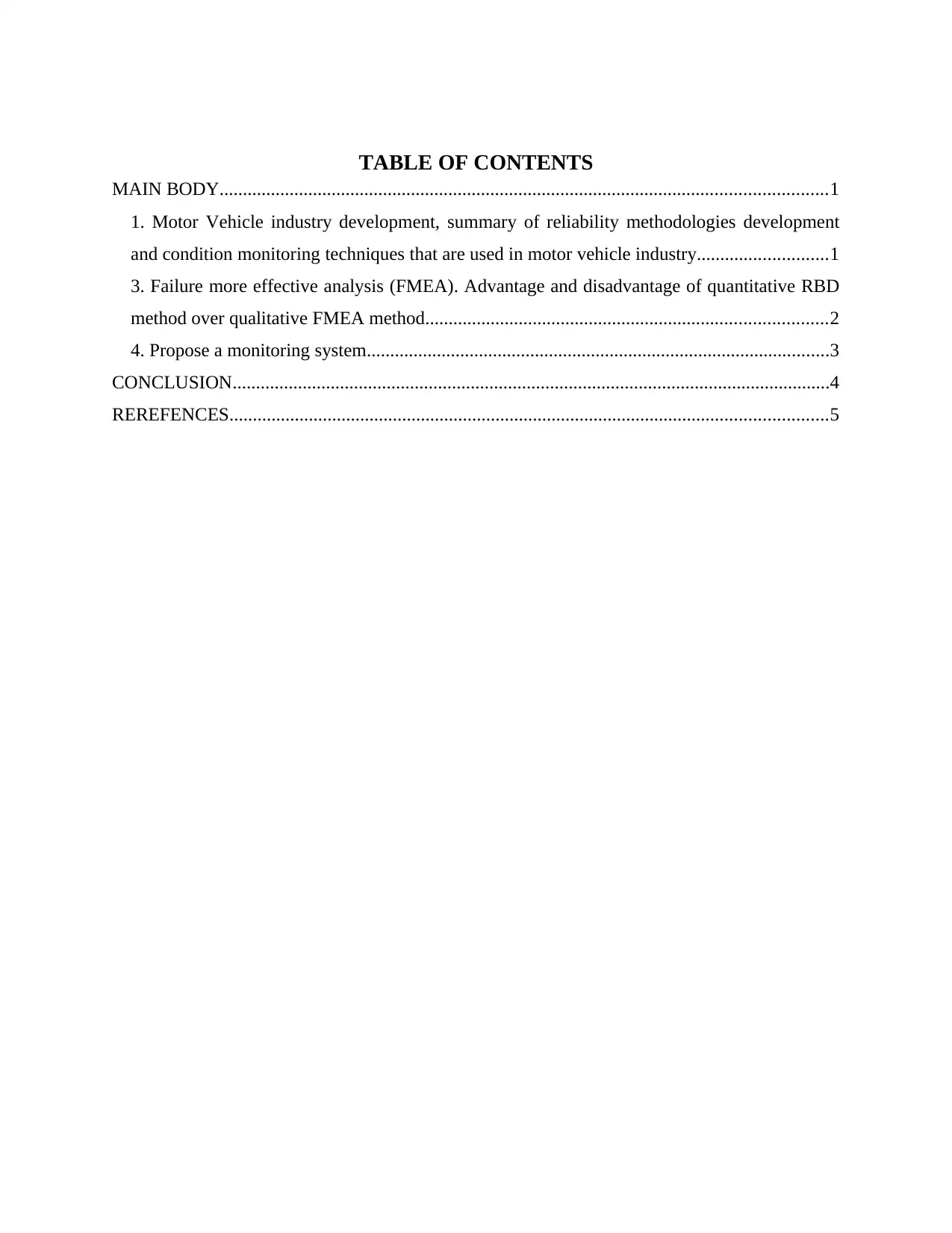
TABLE OF CONTENTS
MAIN BODY..................................................................................................................................1
1. Motor Vehicle industry development, summary of reliability methodologies development
and condition monitoring techniques that are used in motor vehicle industry............................1
3. Failure more effective analysis (FMEA). Advantage and disadvantage of quantitative RBD
method over qualitative FMEA method......................................................................................2
4. Propose a monitoring system...................................................................................................3
CONCLUSION................................................................................................................................4
REREFENCES................................................................................................................................5
MAIN BODY..................................................................................................................................1
1. Motor Vehicle industry development, summary of reliability methodologies development
and condition monitoring techniques that are used in motor vehicle industry............................1
3. Failure more effective analysis (FMEA). Advantage and disadvantage of quantitative RBD
method over qualitative FMEA method......................................................................................2
4. Propose a monitoring system...................................................................................................3
CONCLUSION................................................................................................................................4
REREFENCES................................................................................................................................5
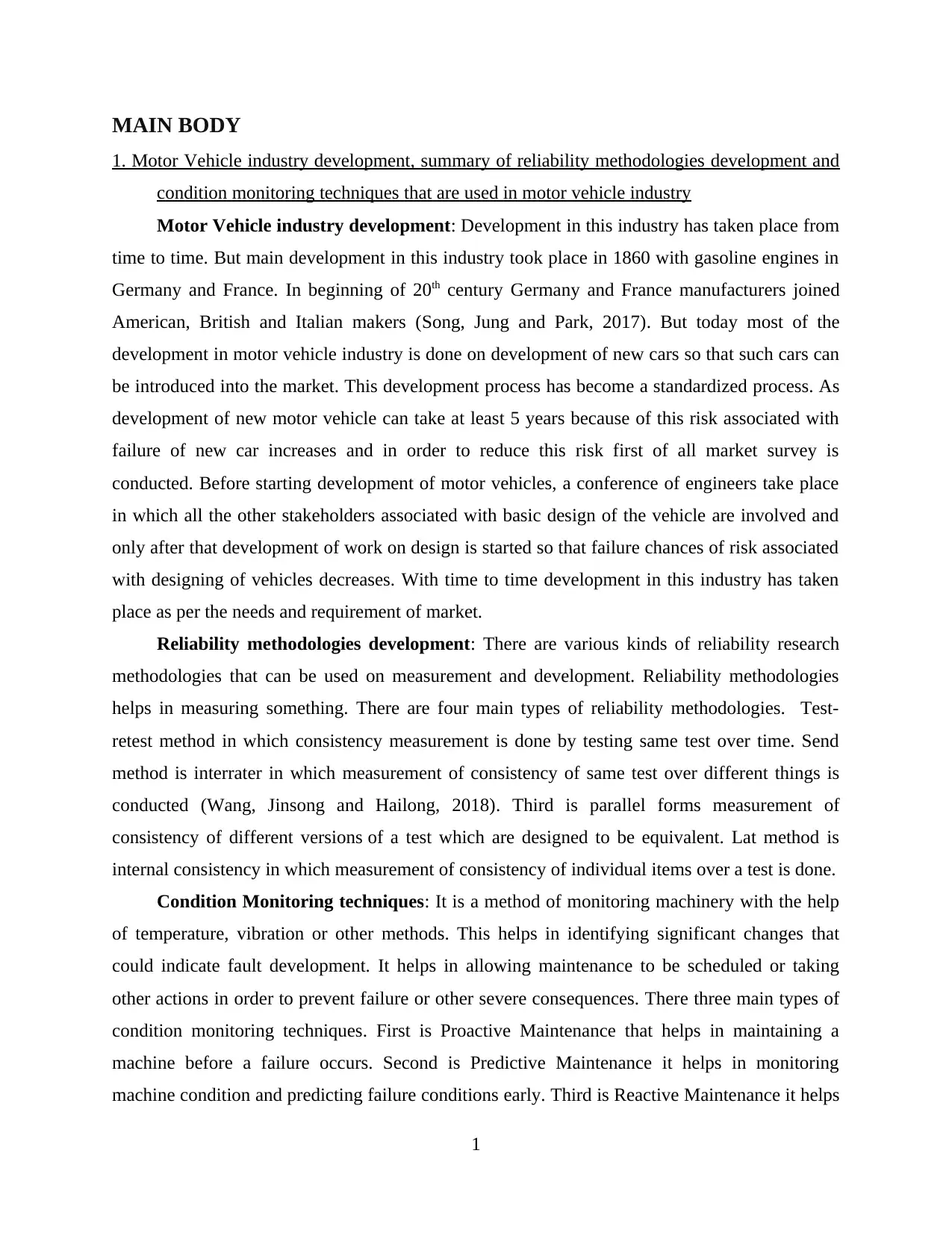
MAIN BODY
1. Motor Vehicle industry development, summary of reliability methodologies development and
condition monitoring techniques that are used in motor vehicle industry
Motor Vehicle industry development: Development in this industry has taken place from
time to time. But main development in this industry took place in 1860 with gasoline engines in
Germany and France. In beginning of 20th century Germany and France manufacturers joined
American, British and Italian makers (Song, Jung and Park, 2017). But today most of the
development in motor vehicle industry is done on development of new cars so that such cars can
be introduced into the market. This development process has become a standardized process. As
development of new motor vehicle can take at least 5 years because of this risk associated with
failure of new car increases and in order to reduce this risk first of all market survey is
conducted. Before starting development of motor vehicles, a conference of engineers take place
in which all the other stakeholders associated with basic design of the vehicle are involved and
only after that development of work on design is started so that failure chances of risk associated
with designing of vehicles decreases. With time to time development in this industry has taken
place as per the needs and requirement of market.
Reliability methodologies development: There are various kinds of reliability research
methodologies that can be used on measurement and development. Reliability methodologies
helps in measuring something. There are four main types of reliability methodologies. Test-
retest method in which consistency measurement is done by testing same test over time. Send
method is interrater in which measurement of consistency of same test over different things is
conducted (Wang, Jinsong and Hailong, 2018). Third is parallel forms measurement of
consistency of different versions of a test which are designed to be equivalent. Lat method is
internal consistency in which measurement of consistency of individual items over a test is done.
Condition Monitoring techniques: It is a method of monitoring machinery with the help
of temperature, vibration or other methods. This helps in identifying significant changes that
could indicate fault development. It helps in allowing maintenance to be scheduled or taking
other actions in order to prevent failure or other severe consequences. There three main types of
condition monitoring techniques. First is Proactive Maintenance that helps in maintaining a
machine before a failure occurs. Second is Predictive Maintenance it helps in monitoring
machine condition and predicting failure conditions early. Third is Reactive Maintenance it helps
1
1. Motor Vehicle industry development, summary of reliability methodologies development and
condition monitoring techniques that are used in motor vehicle industry
Motor Vehicle industry development: Development in this industry has taken place from
time to time. But main development in this industry took place in 1860 with gasoline engines in
Germany and France. In beginning of 20th century Germany and France manufacturers joined
American, British and Italian makers (Song, Jung and Park, 2017). But today most of the
development in motor vehicle industry is done on development of new cars so that such cars can
be introduced into the market. This development process has become a standardized process. As
development of new motor vehicle can take at least 5 years because of this risk associated with
failure of new car increases and in order to reduce this risk first of all market survey is
conducted. Before starting development of motor vehicles, a conference of engineers take place
in which all the other stakeholders associated with basic design of the vehicle are involved and
only after that development of work on design is started so that failure chances of risk associated
with designing of vehicles decreases. With time to time development in this industry has taken
place as per the needs and requirement of market.
Reliability methodologies development: There are various kinds of reliability research
methodologies that can be used on measurement and development. Reliability methodologies
helps in measuring something. There are four main types of reliability methodologies. Test-
retest method in which consistency measurement is done by testing same test over time. Send
method is interrater in which measurement of consistency of same test over different things is
conducted (Wang, Jinsong and Hailong, 2018). Third is parallel forms measurement of
consistency of different versions of a test which are designed to be equivalent. Lat method is
internal consistency in which measurement of consistency of individual items over a test is done.
Condition Monitoring techniques: It is a method of monitoring machinery with the help
of temperature, vibration or other methods. This helps in identifying significant changes that
could indicate fault development. It helps in allowing maintenance to be scheduled or taking
other actions in order to prevent failure or other severe consequences. There three main types of
condition monitoring techniques. First is Proactive Maintenance that helps in maintaining a
machine before a failure occurs. Second is Predictive Maintenance it helps in monitoring
machine condition and predicting failure conditions early. Third is Reactive Maintenance it helps
1
⊘ This is a preview!⊘
Do you want full access?
Subscribe today to unlock all pages.

Trusted by 1+ million students worldwide

in maintaining a machine once the failure occurs. These are the three main types of Condition
Monitoring techniques that are used by engineers for understanding certain machineries. Not
only this, these techniques require various kinds of maintenance. Out of all the above techniques
reactive maintenance technique is one of the most effective and predictive maintenance.
technique.
3. Failure more effective analysis (FMEA). Advantage and disadvantage of quantitative RBD
method over qualitative FMEA method
RBD: Reliability block diagram can be defined as a kind of diagrammatic method that can
be used for showing ways in which component reliability contributes to success or failure of any
kind of complex method. It further helps in management of functions in order to prevent failures
by people (Qin and et al., 2017). Using this method Absence of failure state can be achieved by
practising and preventing failures from occurring. It can only be achieved if there is complete
understanding of potential failure in order to prevent any kind of failure from occurring. It is one
of the simplest ways of visualizing complex systems reliability. But it has its own advantages
and disadvantages over other methods such as FMEA. Some of the most common advantages
and disadvantages of this system are as follows:
Advantages: it helps in establishing reliability goals. It also helps in evaluating impact of failure
components on overall safety of the system. It also helps in providing basis of what if analysis.
Not only this, it also helps in allocating reliability components by calculating MTBF. In large
system trouble-shooting cost saving is also provided with the help of this method. It also helps in
establishing system reliability by analyses various system configurations in trade-off studies. It
also determines sensitivity component failure by identifying potential design problems (Jiang,
Wang and Liu, 2016).
Disadvantages: Its main disadvantages are some complex constructs like- branching, standby,
load sharing and many more because it cannot be clearly represented using traditional RBD
constructs.
FMEA: Failure modes and effects analysis can be defined as step by step approach which is
mainly used for identifying all kinds of possible failure in design, process assembling,
manufacturing or in products or services. It is a qualitative method which helps in identifying
something might fail. This method is completely based upon qualitative risk identification,
analysis, evaluation a risk control method. It is another most commonly used qualitative
2
Monitoring techniques that are used by engineers for understanding certain machineries. Not
only this, these techniques require various kinds of maintenance. Out of all the above techniques
reactive maintenance technique is one of the most effective and predictive maintenance.
technique.
3. Failure more effective analysis (FMEA). Advantage and disadvantage of quantitative RBD
method over qualitative FMEA method
RBD: Reliability block diagram can be defined as a kind of diagrammatic method that can
be used for showing ways in which component reliability contributes to success or failure of any
kind of complex method. It further helps in management of functions in order to prevent failures
by people (Qin and et al., 2017). Using this method Absence of failure state can be achieved by
practising and preventing failures from occurring. It can only be achieved if there is complete
understanding of potential failure in order to prevent any kind of failure from occurring. It is one
of the simplest ways of visualizing complex systems reliability. But it has its own advantages
and disadvantages over other methods such as FMEA. Some of the most common advantages
and disadvantages of this system are as follows:
Advantages: it helps in establishing reliability goals. It also helps in evaluating impact of failure
components on overall safety of the system. It also helps in providing basis of what if analysis.
Not only this, it also helps in allocating reliability components by calculating MTBF. In large
system trouble-shooting cost saving is also provided with the help of this method. It also helps in
establishing system reliability by analyses various system configurations in trade-off studies. It
also determines sensitivity component failure by identifying potential design problems (Jiang,
Wang and Liu, 2016).
Disadvantages: Its main disadvantages are some complex constructs like- branching, standby,
load sharing and many more because it cannot be clearly represented using traditional RBD
constructs.
FMEA: Failure modes and effects analysis can be defined as step by step approach which is
mainly used for identifying all kinds of possible failure in design, process assembling,
manufacturing or in products or services. It is a qualitative method which helps in identifying
something might fail. This method is completely based upon qualitative risk identification,
analysis, evaluation a risk control method. It is another most commonly used qualitative
2
Paraphrase This Document
Need a fresh take? Get an instant paraphrase of this document with our AI Paraphraser
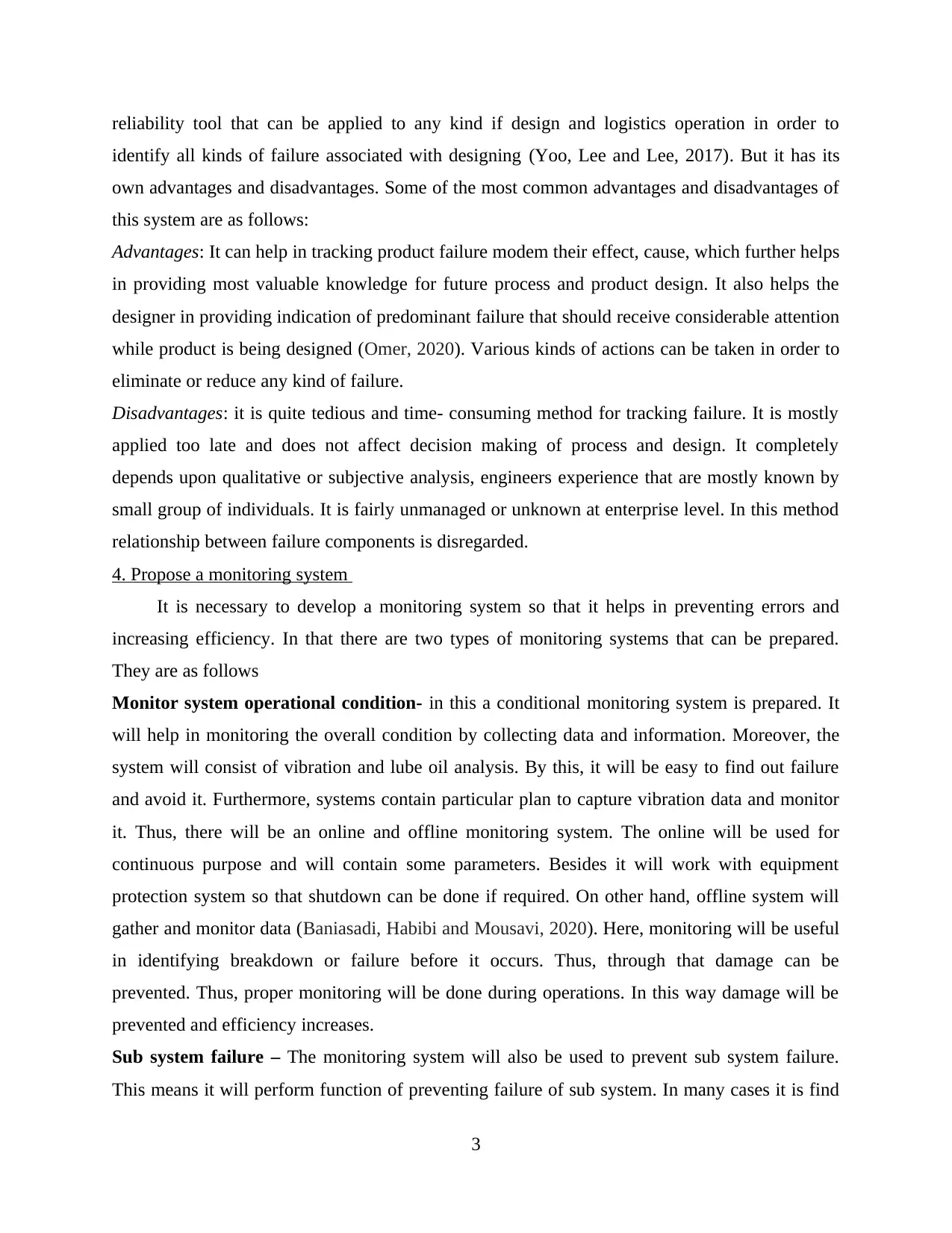
reliability tool that can be applied to any kind if design and logistics operation in order to
identify all kinds of failure associated with designing (Yoo, Lee and Lee, 2017). But it has its
own advantages and disadvantages. Some of the most common advantages and disadvantages of
this system are as follows:
Advantages: It can help in tracking product failure modem their effect, cause, which further helps
in providing most valuable knowledge for future process and product design. It also helps the
designer in providing indication of predominant failure that should receive considerable attention
while product is being designed (Omer, 2020). Various kinds of actions can be taken in order to
eliminate or reduce any kind of failure.
Disadvantages: it is quite tedious and time- consuming method for tracking failure. It is mostly
applied too late and does not affect decision making of process and design. It completely
depends upon qualitative or subjective analysis, engineers experience that are mostly known by
small group of individuals. It is fairly unmanaged or unknown at enterprise level. In this method
relationship between failure components is disregarded.
4. Propose a monitoring system
It is necessary to develop a monitoring system so that it helps in preventing errors and
increasing efficiency. In that there are two types of monitoring systems that can be prepared.
They are as follows
Monitor system operational condition- in this a conditional monitoring system is prepared. It
will help in monitoring the overall condition by collecting data and information. Moreover, the
system will consist of vibration and lube oil analysis. By this, it will be easy to find out failure
and avoid it. Furthermore, systems contain particular plan to capture vibration data and monitor
it. Thus, there will be an online and offline monitoring system. The online will be used for
continuous purpose and will contain some parameters. Besides it will work with equipment
protection system so that shutdown can be done if required. On other hand, offline system will
gather and monitor data (Baniasadi, Habibi and Mousavi, 2020). Here, monitoring will be useful
in identifying breakdown or failure before it occurs. Thus, through that damage can be
prevented. Thus, proper monitoring will be done during operations. In this way damage will be
prevented and efficiency increases.
Sub system failure – The monitoring system will also be used to prevent sub system failure.
This means it will perform function of preventing failure of sub system. In many cases it is find
3
identify all kinds of failure associated with designing (Yoo, Lee and Lee, 2017). But it has its
own advantages and disadvantages. Some of the most common advantages and disadvantages of
this system are as follows:
Advantages: It can help in tracking product failure modem their effect, cause, which further helps
in providing most valuable knowledge for future process and product design. It also helps the
designer in providing indication of predominant failure that should receive considerable attention
while product is being designed (Omer, 2020). Various kinds of actions can be taken in order to
eliminate or reduce any kind of failure.
Disadvantages: it is quite tedious and time- consuming method for tracking failure. It is mostly
applied too late and does not affect decision making of process and design. It completely
depends upon qualitative or subjective analysis, engineers experience that are mostly known by
small group of individuals. It is fairly unmanaged or unknown at enterprise level. In this method
relationship between failure components is disregarded.
4. Propose a monitoring system
It is necessary to develop a monitoring system so that it helps in preventing errors and
increasing efficiency. In that there are two types of monitoring systems that can be prepared.
They are as follows
Monitor system operational condition- in this a conditional monitoring system is prepared. It
will help in monitoring the overall condition by collecting data and information. Moreover, the
system will consist of vibration and lube oil analysis. By this, it will be easy to find out failure
and avoid it. Furthermore, systems contain particular plan to capture vibration data and monitor
it. Thus, there will be an online and offline monitoring system. The online will be used for
continuous purpose and will contain some parameters. Besides it will work with equipment
protection system so that shutdown can be done if required. On other hand, offline system will
gather and monitor data (Baniasadi, Habibi and Mousavi, 2020). Here, monitoring will be useful
in identifying breakdown or failure before it occurs. Thus, through that damage can be
prevented. Thus, proper monitoring will be done during operations. In this way damage will be
prevented and efficiency increases.
Sub system failure – The monitoring system will also be used to prevent sub system failure.
This means it will perform function of preventing failure of sub system. In many cases it is find
3
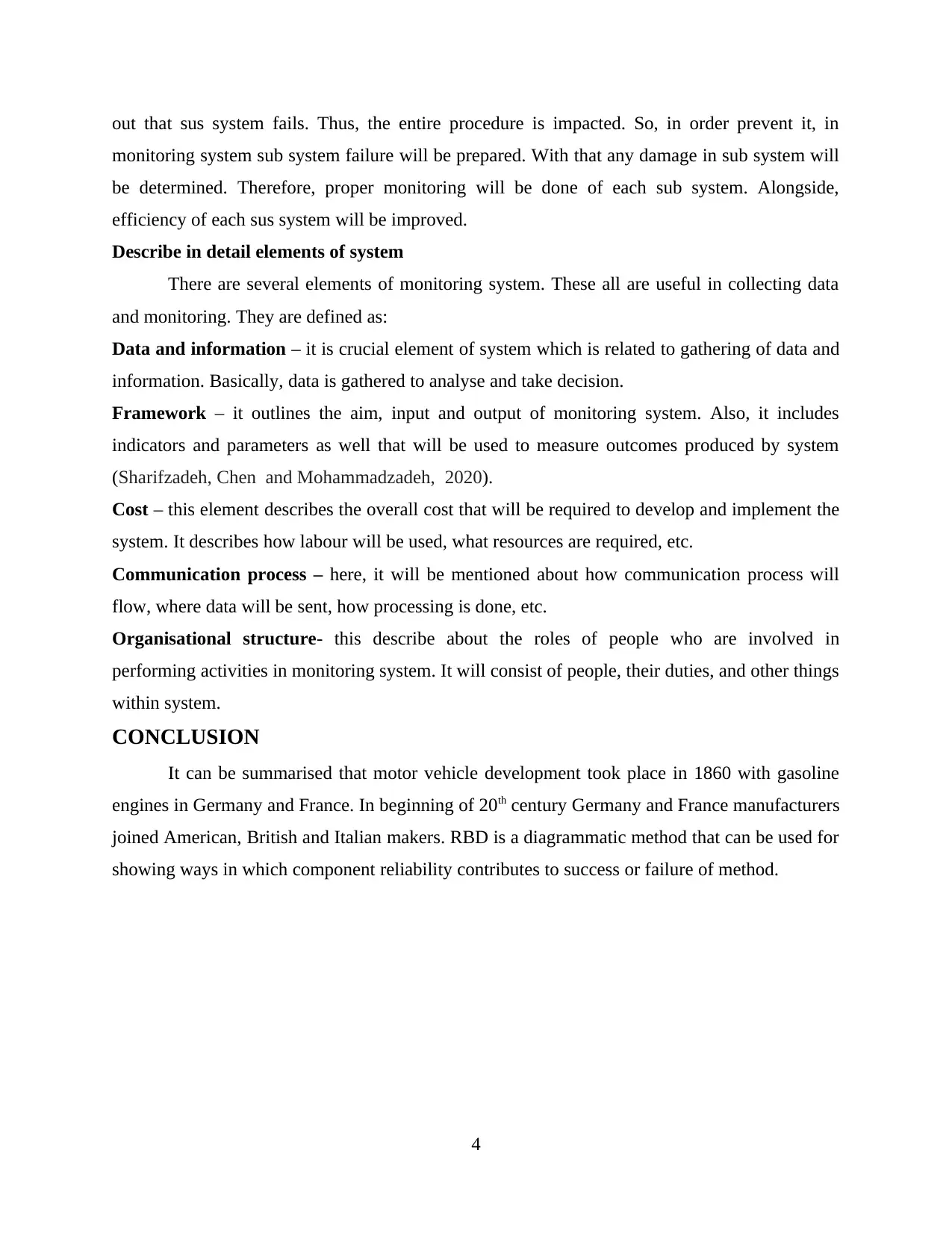
out that sus system fails. Thus, the entire procedure is impacted. So, in order prevent it, in
monitoring system sub system failure will be prepared. With that any damage in sub system will
be determined. Therefore, proper monitoring will be done of each sub system. Alongside,
efficiency of each sus system will be improved.
Describe in detail elements of system
There are several elements of monitoring system. These all are useful in collecting data
and monitoring. They are defined as:
Data and information – it is crucial element of system which is related to gathering of data and
information. Basically, data is gathered to analyse and take decision.
Framework – it outlines the aim, input and output of monitoring system. Also, it includes
indicators and parameters as well that will be used to measure outcomes produced by system
(Sharifzadeh, Chen and Mohammadzadeh, 2020).
Cost – this element describes the overall cost that will be required to develop and implement the
system. It describes how labour will be used, what resources are required, etc.
Communication process – here, it will be mentioned about how communication process will
flow, where data will be sent, how processing is done, etc.
Organisational structure- this describe about the roles of people who are involved in
performing activities in monitoring system. It will consist of people, their duties, and other things
within system.
CONCLUSION
It can be summarised that motor vehicle development took place in 1860 with gasoline
engines in Germany and France. In beginning of 20th century Germany and France manufacturers
joined American, British and Italian makers. RBD is a diagrammatic method that can be used for
showing ways in which component reliability contributes to success or failure of method.
4
monitoring system sub system failure will be prepared. With that any damage in sub system will
be determined. Therefore, proper monitoring will be done of each sub system. Alongside,
efficiency of each sus system will be improved.
Describe in detail elements of system
There are several elements of monitoring system. These all are useful in collecting data
and monitoring. They are defined as:
Data and information – it is crucial element of system which is related to gathering of data and
information. Basically, data is gathered to analyse and take decision.
Framework – it outlines the aim, input and output of monitoring system. Also, it includes
indicators and parameters as well that will be used to measure outcomes produced by system
(Sharifzadeh, Chen and Mohammadzadeh, 2020).
Cost – this element describes the overall cost that will be required to develop and implement the
system. It describes how labour will be used, what resources are required, etc.
Communication process – here, it will be mentioned about how communication process will
flow, where data will be sent, how processing is done, etc.
Organisational structure- this describe about the roles of people who are involved in
performing activities in monitoring system. It will consist of people, their duties, and other things
within system.
CONCLUSION
It can be summarised that motor vehicle development took place in 1860 with gasoline
engines in Germany and France. In beginning of 20th century Germany and France manufacturers
joined American, British and Italian makers. RBD is a diagrammatic method that can be used for
showing ways in which component reliability contributes to success or failure of method.
4
⊘ This is a preview!⊘
Do you want full access?
Subscribe today to unlock all pages.

Trusted by 1+ million students worldwide

REREFENCES
Books and Journals
Omer, A.M., 2020. Design and Operation of Low Energy Consumption Passive Human Comfort
Solutions. Journal of Commerce and Management Thought, 11(1), pp.40-62.
Baniasadi, A., Habibi, D. and Mousavi, N., 2020. Optimal sizing design and operation of
electrical and thermal energy storage systems in smart buildings. Journal of Energy
Storage, 28, p.101186.
Sharifzadeh, M., Chen, W. and Mohammadzadeh, A., 2020. Design and operation of solid oxide
fuel cell systems: challenges and future research directions. In Design and Operation of
Solid Oxide Fuel Cells (pp. 445-463). Academic Press.
Jiang, L., Wang, X. and Liu, Y., 2016, October. Reliability assessment of ZPW-2000A track
circuit using Bayesian network. In 2016 11th International Conference on Reliability,
Maintainability and Safety (ICRMS) (pp. 1-4). IEEE.
Song, H., Jung, D. and Park, B., 2017, June. A case study on reliability assessment for LRV&
LRW. In 2017 14th International Conference on Ubiquitous Robots and Ambient
Intelligence (URAI) (pp. 701-702). IEEE.
Qin, S., and et al., 2017, July. A method of reliability synthetic modeling considering multi-
feature for APMS. In 2017 Prognostics and System Health Management Conference
(PHM-Harbin) (pp. 1-4). IEEE.
Yoo, S.Y., Lee, S.B. and Lee, S.S., 2017, July. Development of Reliability-Centered
Maintenance System for Equipment of FLNG. In The 27th International Ocean and
Polar Engineering Conference. International Society of Offshore and Polar Engineers.
Wang, P., Jinsong, L. and Hailong, B., 2018, May. Fault tracing method for high voltage
electronic current transformer during its performance test based on the FMEA. In 2018
IEEE International Instrumentation and Measurement Technology Conference
(I2MTC) (pp. 1-5). IEEE
5
Books and Journals
Omer, A.M., 2020. Design and Operation of Low Energy Consumption Passive Human Comfort
Solutions. Journal of Commerce and Management Thought, 11(1), pp.40-62.
Baniasadi, A., Habibi, D. and Mousavi, N., 2020. Optimal sizing design and operation of
electrical and thermal energy storage systems in smart buildings. Journal of Energy
Storage, 28, p.101186.
Sharifzadeh, M., Chen, W. and Mohammadzadeh, A., 2020. Design and operation of solid oxide
fuel cell systems: challenges and future research directions. In Design and Operation of
Solid Oxide Fuel Cells (pp. 445-463). Academic Press.
Jiang, L., Wang, X. and Liu, Y., 2016, October. Reliability assessment of ZPW-2000A track
circuit using Bayesian network. In 2016 11th International Conference on Reliability,
Maintainability and Safety (ICRMS) (pp. 1-4). IEEE.
Song, H., Jung, D. and Park, B., 2017, June. A case study on reliability assessment for LRV&
LRW. In 2017 14th International Conference on Ubiquitous Robots and Ambient
Intelligence (URAI) (pp. 701-702). IEEE.
Qin, S., and et al., 2017, July. A method of reliability synthetic modeling considering multi-
feature for APMS. In 2017 Prognostics and System Health Management Conference
(PHM-Harbin) (pp. 1-4). IEEE.
Yoo, S.Y., Lee, S.B. and Lee, S.S., 2017, July. Development of Reliability-Centered
Maintenance System for Equipment of FLNG. In The 27th International Ocean and
Polar Engineering Conference. International Society of Offshore and Polar Engineers.
Wang, P., Jinsong, L. and Hailong, B., 2018, May. Fault tracing method for high voltage
electronic current transformer during its performance test based on the FMEA. In 2018
IEEE International Instrumentation and Measurement Technology Conference
(I2MTC) (pp. 1-5). IEEE
5
1 out of 7
Related Documents
Your All-in-One AI-Powered Toolkit for Academic Success.
+13062052269
info@desklib.com
Available 24*7 on WhatsApp / Email
![[object Object]](/_next/static/media/star-bottom.7253800d.svg)
Unlock your academic potential
Copyright © 2020–2025 A2Z Services. All Rights Reserved. Developed and managed by ZUCOL.





